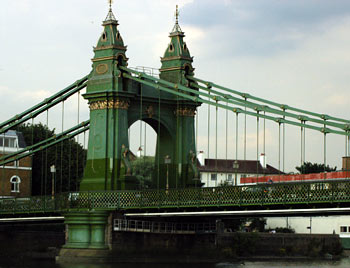Hammersmith Bridge Could 'Soon Dismantle On Its Own'
BBC reports that bridge may be too weak to support single decker buses
Hammersmith Bridge may be too weak to support single decker buses, according to a report seen by BBC London.
BBC London says it gained sight of the report through a Freedom of Information request, and though Transport for London has not denied the information in the report, it insists the historic bridge, designed by Sir Joseph Bazalgette and first opened in 1887 is safe provided bus numbers are strictly controlled.

In May, TfL took steps to limit the number of buses " in order to preserve the lifespan of Hammersmith Bridge prior to strengthening works".
Since then, only one bus is allowed to use the bridge in each direction at any one time.
However, BBC reporter Gareth Furby found that some drivers are ignoring these instructions and found up to three buses crossing the bridge at the same time.
He reported seeing extensive correspondence between H&F Council and TfL about "the sorry state of the bridge" with one council officer saying: " It is possible that the excessive vibration caused by buses is causing the nuts and bolts to become loose.
"Soon this bridge will dismantle on its own!"
The BBC Freedom of Information request also uncovered a report by engineering consultancy Hyder for H&F Council which stated the bridge is non-compliant for vehicles weighing over 7.5 tonnes.
Leader of the Conservative opposition in the council, Cllr Greg Smith said: " Buses are heavier than seven and a half tonnes. It doesn't take much to do the maths and work out that if you have more than that weight on the bridge, the bridge could collapse."
TfL has responded saying this non-compliance is only with the worst case scenario and further analysis has shown it is safe to have more than one bus on the bridge. It also says that strengthening the bridge could cost more than £25 million.
H&F Council says that if the one bus rule is not complied with, it will have no choice but to close the bridge.
Hammersmith Bridge suffered structural problems for years and has been closed for lengthy periods on several occasions, due to the weight and volume of road traffic which it was not originally designed to support.
In February 1997 the bridge was closed to all traffic except buses, bicycles, motorcycles, emergency vehicles and pedestrians to allow further essential repair works. Structural elements of the bridge had been found to be corroded or worn, in particular cross girders and deck surfacing, as well as some areas of masonry.
The bridge re-opened in July 1998 to all road users, subject to a 7.5-tonne weight restriction and with a priority measure in place for buses. Local bus flow was controlled by traffic lights, and routes were required to convert from double-decker buses to smaller single-deckers to reduce the load on the bridge.
As part of the renovations following the IRA bomb attack in 2000, the bridge received a complete new paint job restoring it to the original colour scheme of 1887, and new lighting was installed.
September 7, 2016